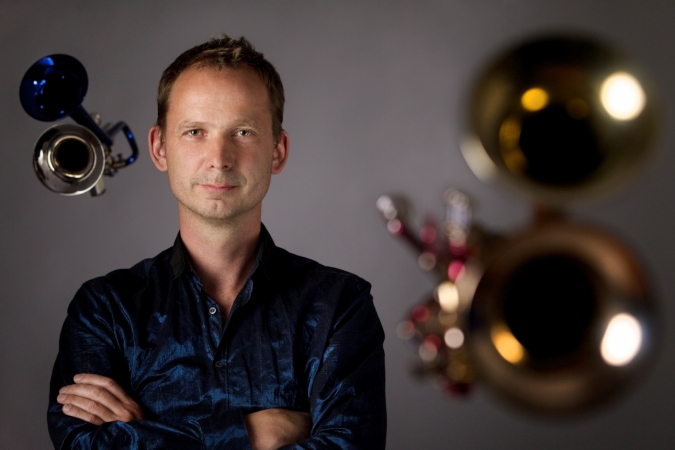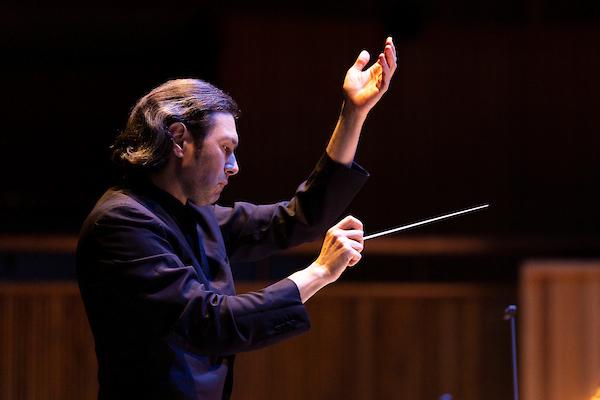It’s Beethoven with everything for 2020, the composer’s 250th anniversary year. But the London Philharmonic has devised an interesting approach for their Beethoven-themed programming. “2020 Vision” is a series of concerts which couple a work by Beethoven, or occasionally one of his contemporaries, with a piece written 100 years later and another written 200 years later. The result is a series of gloriously eclectic programmes, not least for the obscurity of the later works chosen. In this opening concert, Beethoven’s First Symphony (1801) was followed by Snatches of a Conversation (2001) by Peter Eötvös, and Scriabin’s Second Symphony (1901).
The London Philharmonic fielded a relatively large string section for the Beethoven, but with their disciplined ensemble, they were as agile as a string quartet. The rich string sound balanced the rhythmic clarity and precision that Jurowski brought to the score. Ever-tasteful in the Classical-era repertoire, Jurowski never exaggerated any of Beethoven’s dramatic gestures. The Andante cantabile second movement felt a little stiff, as if the woodwind melodies could do with more freedom, but Jurowski’s rhythmic focus proved ideal for the scherzo that followed. In the finale, Jurowski toyed playfully with the stop-and-start introduction, but launched into the movement proper with vivacious energy, drawing impressively broad textures from the strings, but without ever compromising the rhythmic focus.
Snatches of a Conversation could be a trumpet concerto, but it could equally be a work of absurdist theatre. It is scored for a speaker (Omar Ebrahim) and a trumpeter (Marco Blaauw, pictured below by Klaus Rudolph), playing a double-bell instrument. The second bell projects upwards from the body of the instrument, Dizzy Gillespie-style, and allows the player to alternate quickly between open and muted sounds. The speaker is hardly a soloist, he sits at the back of the ensemble, here obscured by a large loudspeaker, and his words are amplified.  As the title suggests, the text is made up of brief snatches of trivial conversation, to which the trumpet responds with a range of quasi-vocal textures and virtuosic outbursts. The style is jazzy, especially in the trumpet part, but also from the small ensemble, which includes prominent saxophone and trombone. The surrealism also looks back to Berio’s Sinfonia, although Eötvös is more playful and impulsive. The work received an excellent performance here, with Blaaw a suitably virtuosic and extrovert soloist, and Ebrahim a suitably surreal conversationalist. As in the opening of Beethoven’s finale, Jurowski again delivered perfect comic timing.
As the title suggests, the text is made up of brief snatches of trivial conversation, to which the trumpet responds with a range of quasi-vocal textures and virtuosic outbursts. The style is jazzy, especially in the trumpet part, but also from the small ensemble, which includes prominent saxophone and trombone. The surrealism also looks back to Berio’s Sinfonia, although Eötvös is more playful and impulsive. The work received an excellent performance here, with Blaaw a suitably virtuosic and extrovert soloist, and Ebrahim a suitably surreal conversationalist. As in the opening of Beethoven’s finale, Jurowski again delivered perfect comic timing.
Scriabin’s Second Symphony is as difficult to pin down as the Eötvös. It is a huge, late-Romantic work, indulgently expansive, and with many moments of great beauty. The music seems to alternate between two sides of Scriabin’s personality, with genteel string passages, that can sound as reserved as Elgar, leading to dissonant brass-laden climaxes as fraught and angst-ridden as anything from the Second Viennese School. Jurowski proved the ideal guide through this complex maze of colours and moods. He shaped the first movement with a firm hand, reigning in the composer’s excesses and clearly delineating the returning themes. Disciplined string coordination, this time from a huge ensemble, brought textural and harmonic clarity. Some excellent woodwind solos also stood out, especially the clarinet solos of Benjamin Mellefont in the first movement, and the birdcalls of flautist Juliette Bausor in the third.
The lower brass were less focussed, especially in the first movement, where Scriabin’s orchestration is often dense and bottom heavy. But they fared better in the finale, a triumphant Maestoso that seems pasted onto the end of the otherwise dark and sombre work. Jurowski played this for all it was worth, and every section of the orchestra shone for these final few minutes. The symphony is a curiosity, but Jurowski made the best possible case for it, skilfully shaping the music to bolster its flimsy structure, but without underplaying its many beguiling eccentricities.














Add comment